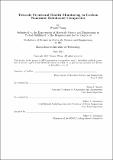| dc.contributor.advisor | Brian L. Wardle and Jeffrey C. Grossman. | en_US |
| dc.contributor.author | Wang, Wennie | en_US |
| dc.contributor.other | Massachusetts Institute of Technology. Department of Materials Science and Engineering. | en_US |
| dc.date.accessioned | 2013-09-24T18:22:52Z | |
| dc.date.available | 2013-09-24T18:22:52Z | |
| dc.date.copyright | 2013 | en_US |
| dc.date.issued | 2013 | en_US |
| dc.identifier.uri | http://hdl.handle.net/1721.1/80904 | |
| dc.description | Thesis (S.B.)--Massachusetts Institute of Technology, Dept. of Materials Science and Engineering, 2013. | en_US |
| dc.description | This electronic version was submitted by the student author. The certified thesis is available in the Institute Archives and Special Collections. | en_US |
| dc.description | Cataloged from student-submitted PDF version of thesis. | en_US |
| dc.description | Includes bibliographical references (p. 51-56). | en_US |
| dc.description.abstract | An experimental investigation was conducted to understand the non-destructive evaluation (NDE) capabilities of carbon nanotubes (CNTs) of several network architectures towards structural health monitoring (SHM). As heterogeneous composite structures become increasingly common in industry, detecting mechanical damage and damage accumulation becomes increasingly difficult as many modes of failure occur below the external surface. Traditional SHM techniques may be time consuming and costly; however, CNTs are a unique material that shows promise as a strain or damage sensor. Three different laminate samples types with various CNT network architectures were tested in open-hole tension. Samples tested were quasiisotropic carbon fiber, carbon fiber prepreg with unidirectional knocked-down CNT surface patch, and fuzzy fiber reinforced plastic (FFRP) samples, which consist of radially grown CNTs on a woven ceramic fiber substrate. Mechanical load and electrical resistance were simulataneously measured using three different probes configurations with respect to the tensile direction that measured either surface or through thickness resistance changes. Measurements were taken near and away from the stress concentration. Results indicated that different CNT network architectures influenced the consistency and efficacy of indicating damage acculumation. Changes in electrical resistance correlated strongly with sample mechanical damage accumulation for unidirectional knocked-down CNTs, but had more consistent values and readings for the FFRP samples, indicating that CNT network architecture beyond the inherent piezoresistivity of the CNT heavily influences the NDE capabilities of using CNTs as strain or damage sensors. Results also suggest that CNT network architecture must be further optimized to achieve reliable NDE and SHM, and may depend on the desired application. | en_US |
| dc.description.statementofresponsibility | by Wennie Wang. | en_US |
| dc.format.extent | 70 p. | en_US |
| dc.language.iso | eng | en_US |
| dc.publisher | Massachusetts Institute of Technology | en_US |
| dc.rights | M.I.T. theses are protected by
copyright. They may be viewed from this source for any purpose, but
reproduction or distribution in any format is prohibited without written
permission. See provided URL for inquiries about permission. | en_US |
| dc.rights.uri | http://dspace.mit.edu/handle/1721.1/7582 | en_US |
| dc.subject | Materials Science and Engineering. | en_US |
| dc.title | Towards structural health monitoring in carbon nanotube reinforced composites | en_US |
| dc.type | Thesis | en_US |
| dc.description.degree | S.B. | en_US |
| dc.contributor.department | Massachusetts Institute of Technology. Department of Materials Science and Engineering | |
| dc.identifier.oclc | 858282993 | en_US |
